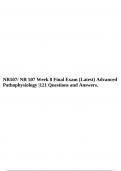Exam (elaborations)
NR507/ NR 507 Week 8 Final Exam (Latest) Advanced Pathophysiology |121 Questions and Answers.
- Course
- Institution
NR507/ NR 507 Week 8 Final Exam (Latest) Advanced Pathophysiology |121 Questions and Answers. Question 1 What is the major virus involved in the development of cervical cancer? a) Herpes simplex virus type 6 b) Herpes simplex virus type 2 c) Human papillomavirus d) Human immunodeficiency virus Q...
[Show more]



